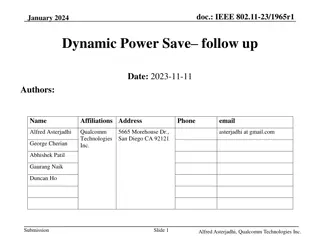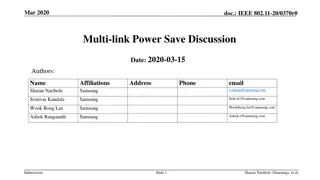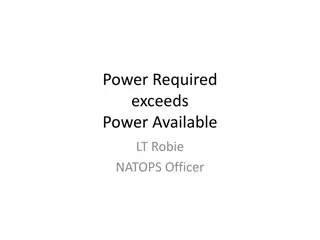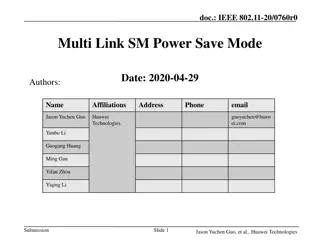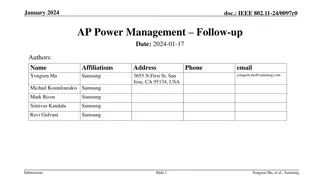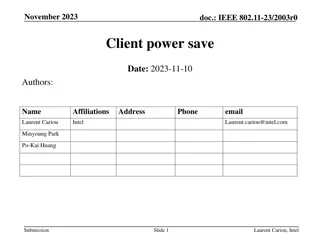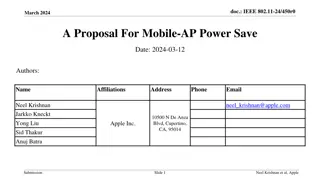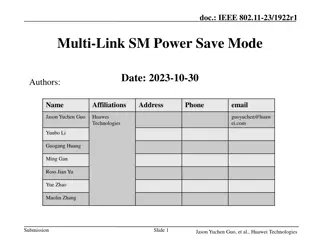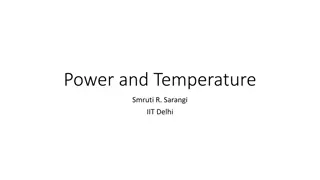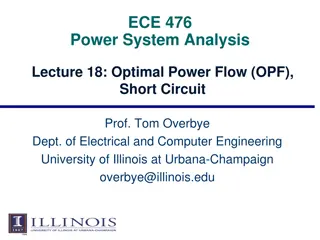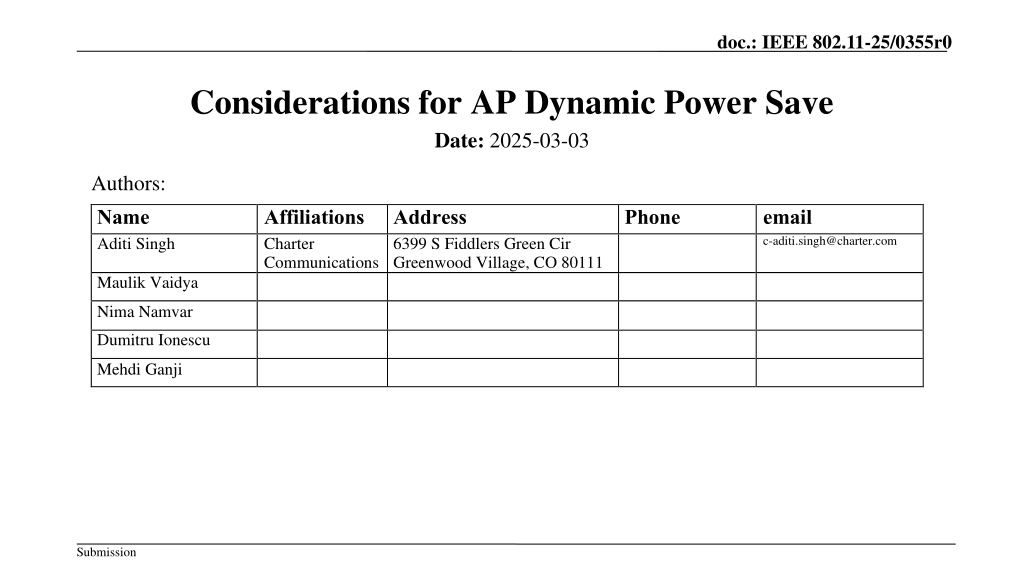
AP Dynamic Power Save Considerations Overview
Explore considerations for dynamic power save mechanisms in APs to minimize energy consumption without compromising performance requirements. Learn about available options, power management modes, and the potential impact on different devices. Discover related works and insights into efficient power saving protocols for APs.
Download Presentation

Please find below an Image/Link to download the presentation.
The content on the website is provided AS IS for your information and personal use only. It may not be sold, licensed, or shared on other websites without obtaining consent from the author. If you encounter any issues during the download, it is possible that the publisher has removed the file from their server.
You are allowed to download the files provided on this website for personal or commercial use, subject to the condition that they are used lawfully. All files are the property of their respective owners.
The content on the website is provided AS IS for your information and personal use only. It may not be sold, licensed, or shared on other websites without obtaining consent from the author.
E N D
Presentation Transcript
doc.: IEEE 802.11-25/0355r0 Considerations for AP Dynamic Power Save Date: 2025-03-03 Authors: Name Aditi Singh Affiliations Charter Communications Address 6399 S Fiddlers Green Cir Greenwood Village, CO 80111 Phone email c-aditi.singh@charter.com Maulik Vaidya Nima Namvar Dumitru Ionescu Mehdi Ganji Submission
March 2025 doc.: IEEE 802.11-25/0355r0 Introduction The key objective of AP Power Save is to reduce power consumption for APs without impacting the latency or throughput requirements of non-AP STAs There are limited number of options available for AP power save Reduction of bandwidth Reduction of number of Spatial Streams Disable links (if MLO available) The current standard allows the AP to change these parameters AP power management has two modes: Active mode and power save mode In power save mode, the AP is either in doze state or awake state For example, in doze state AP disables its radio interface, and it does not transmit, receive, or listen In awake state the AP operates with its full capabilities, and it can transmit, or receive Dynamic power save i.e. listen state using minimum capabilities has been introduced for non-AP STAs and mobile APs[1] This is envisioned to reduce power in both listen and receive modes However, a similar mechanism tailored to the specific operations of AP is not a part of SFD yet Dynamic AP power save allows APs to save power dynamically by switching capabilities Impactful power saving potential for UHR APs Legacy STAs may experience significant impact In this contribution, we provide considerations on Dynamic AP Power Save Slide 2 Submission Aditi Singh et al., Charter Communications
March 2025 doc.: IEEE 802.11-25/0355r0 Related Work Several contributions discuss Dynamic Power Save (DPS) for an AP: [1] discusses candidate power save protocols describing the requirements, target power saving that can be achieved as well as issues that need careful considerations [2] provide thoughts on details of DPS operation for an AP. Presents solutions to prevent loss of medium synchronization during transition in different modes [3] proposes consideration of different power save modes based on the scenario and the STAs present [4] describes the information element options available to specify an AP s schedule, power state, capability, and management info. to the non-AP STAs for power save mode Submission Slide 3 Aditi Singh et al., Charter Communications
March 2025 doc.: IEEE 802.11-25/0355r0 AP Power Save Summary AP PS Mechanism Signaling Energy saving Schedule Duration Compatibility Scheduled Use TWT signaling High Long Does not work with Legacy devices *Dynamic ICF with intermediate FCS and padding, ICR Medium Short Limited due to the backward compatibility issues related with legacy Cross Link Cross link wake-up frame (Reuse AP Assistance Request control info. field) High Short High due to the presence of at least one active link * Not a part of SFD yet In DPS, an AP can transmit beacons and management frames, listen to the channel; and communicate with legacy STAs, as well as with DPS-capable STAs which can be served without increasing the AP s capabilities AP is capable of exchanging non-HT dup format PPDUs Submission Slide 4 Aditi Singh et al., Charter Communications
March 2025 doc.: IEEE 802.11-25/0355r0 Motivation In general, the AP is always expected to be ON, always operating in its full capability state As most APs are wall-powered, the need to save power at APs is often overlooked However, the introduction of MLO makes power save a crucial issue for APs There are scenarios e.g. In enterprise / managed Wi-Fi setups where the service provider is expected to be, via contractual obligations, responsible for cost of utilities (e.g., power). In outdoor deployment of Wi-Fi APs where APs may not use constant-power source e.g., when mounted on DOCSIS- strands Scheduled PS can work well in network traffic predictable cases, such as office buildings where low/no traffic is expected at night-time and weekends. However, if the managed network covers an area such as downtown where the AP is on a strand applying a scheduled power save may not work due to the dynamic nature of its usage In such cases, we need AP power saving methods that can dynamically change capabilities to save power and ensure uninterrupted services Submission Slide 5 Aditi Singh et al., Charter Communications
March 2025 doc.: IEEE 802.11-25/0355r0 Motivation(cont.) TWT based scheduled AP PS allows AP to be in doze state outside the TWT SPs. However, there are several considerations such as The AP cannot go in doze state in presence of legacy devices The doze state must consider QoS requirements of the associated STAs After negotiating the schedule, the devices don t always wake up accurately In presence of multiple STAs, an AP does not get many opportunities to be in doze state as it is responsible for sending out the beacon and management frames Dynamic PS with AP operating in minimum capability state allows the AP to serve legacy devices while maintaining minimum Tx/Rx operation and the possibility to transition to higher capability state when triggered by a non-AP STA Frames that need to be exchanged for transition to higher capability state need to be designed such that they do not interfere with the operation of legacy devices Dynamic power save could provide significant improvement for power saving in scenarios where, the network traffic is unpredictable and traditional power saving schemes such as scheduled PS are not applicable Submission Slide 6 Aditi Singh et al., Charter Communications
March 2025 doc.: IEEE 802.11-25/0355r0 Summary Brief discussion on the available AP power save techniques We describe scenarios in which AP power save is critical either due to the AP not being wall-powered or the expenses incurred by the operator Scheduled power save can help reduce power consumption during down time, however, there are scenarios where it may not be applicable due to dynamic utilization of the network Therefore, a technique such as dynamic power save in which the AP is essentially in listen sate with some limited Tx/Rx capabilities can provide some significant power reduction Highlights the need for dynamic power save in APs Submission Slide 7 Aditi Singh et al., Charter Communications
March 2025 doc.: IEEE 802.11-25/0355r0 References [1] 24/2016, PDT MAC Power Save [2] 23/0010, Considerations for enabling AP Power Save [2] 24/0451, AP state transitions in DPS mode [3] 24/0833, Dynamic Power Saving for AP [4] 24/0097, AP Power Management Follow-up Submission Slide 8 Aditi Singh et al., Charter Communications


